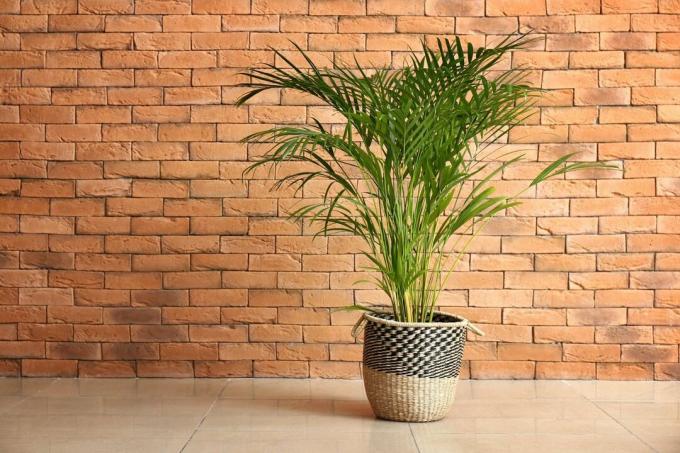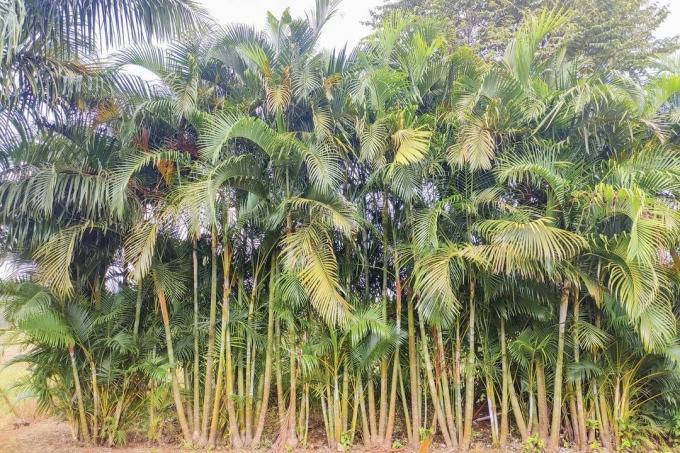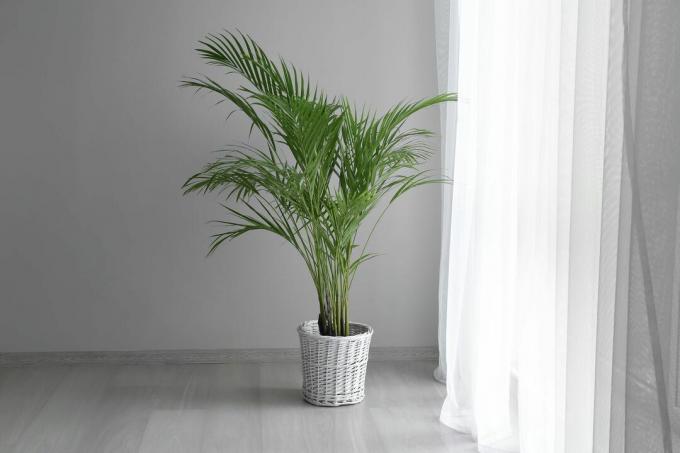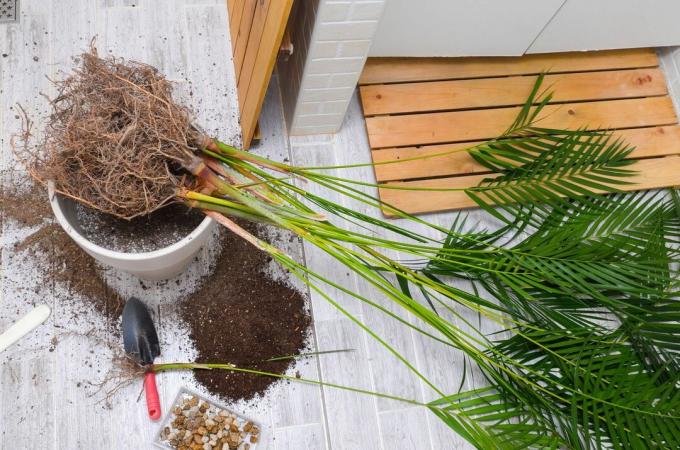The golden fruit palm not only looks beautiful, but also has an air-purifying effect. Here you will learn how to properly care for the Areca palm and that it can even be kept in water.

The golden fruit palm, also Areca palm (Dypsis lutescens) is a popular indoor and office plant due to its refreshing appearance with feathery leaves. It is considered to be particularly air-purifying and can be kept not only in classic soil culture, but also in hydroponics. In this article we will show you what is important when it comes to maintenance and how to recognize common mistakes.
contents
- Golden fruit palm: flower, origin and properties
- You should pay attention to this when planting: location, soil and Co.
-
Gold fruit palm care: The most important measures
- Water dypsis lutescens
- Fertilize golden fruit palm
- Cut areca palm
- Repot golden fruit palm
- pests and diseases
- Propagate golden fruit palm
- Is the golden fruit palm poisonous?
Golden fruit palm: flower, origin and properties
The Areca palm belongs to the palm family (Arecaceae) and originally comes from the tropics of Madagascar, where it can reach a height of up to ten meters. Its flowers are small and light yellow in color, the fruits are golden yellow and have given the golden fruit palm its name. However, as a houseplant in our apartments, the Areca palm does not grow taller than three meters and almost never flowers. Nevertheless, it is very popular with its evergreen, feather-like leaves and upright growth. It is also said to have a strong air purification ability and high oxygen production, which is why it is particularly popular in offices.

You should pay attention to this when planting: location, soil and Co.
The golden fruit palm likes it bright and warm and always needs a fresh to moist substrate. In spring, the tropical plant can be placed in a pot with classic green plant soil - such as ours Plantura organic universal soil - are planted, which ensures a good supply of nutrients and offers the areca palm optimal conditions with its pH value in the slightly acidic range. To ensure permanent drainage, it is recommended to mix the soil with at least 30% sand, pumice or lava split.
It is also important that excess water can drain out of the pot, because the golden fruit palm cannot endure waterlogging. The pot should be as deep as possible, since the golden fruit palm forms a taproot that requires a lot of space below.
The plant should then be placed in a bright spot with sufficient light but not direct sunlight. A consistently warm temperature and high humidity are also important. In winter, the golden fruit palm can also endure lower temperatures, but these should always be between 15 and 24 °C.
The areca palm can also be cared for in hydroponics without any problems. Here, the plant is kept without soil, but exclusively in water or in a nutrient solution. To do this, fill a container with expanded clay or another suitable substrate such as expanded slate or lava granules, which gives the plant support and provides enough air for the roots. The water is then in a pot. A water level meter shows the water requirement, a special hydroponic fertilizer provides the necessary nutrients. Hydroponics also automatically increases the humidity around the plant, making it possible to water in bulk too.

Gold fruit palm care: The most important measures
The care of the Areca palm is not complicated, but it is important to take care of the plant regularly. According to their tropical origin with rainy and dry season, high humidity and warm temperatures, the golden fruit palm also needs adapted care as a houseplant in summer and in winter Winter.
Water dypsis lutescens
When watering, it is important that the areca palm never dries out, but also never stands in water. A bit of practice is required here. The amount of water varies depending on the size of the plant and the volume of the container. Basically, it is better to water more often and little than infrequently and a lot at once. The substrate should always be nice and moist. As soon as the top layer of soil has dried, it must be watered again. Slightly acidic, low-fluoride water should be used. For example, rainwater, which is naturally slightly acidic, distilled water or mineral water without fluoride is suitable. In winter, when the growing season is over, the plant needs less water, but the root ball must not dry out completely.
tip: Since the golden fruit palm needs a high level of humidity, it should be sprayed with water regularly. In winter, it can also help to place a bowl of water on the heater.

Fertilize golden fruit palm
The areca palm needs a lot of nutrients for its growth. It is therefore important to constantly supply the plant with new nutrients through fertilization. Since the golden fruit palm reacts sensitively to choride and fluoride deposits, it is not advisable to use mineral fertilizers, since the nutrients are present here in the form of these salts, among other things. Organic fertilizers are more suitable, for example our predominantly organic one Plantura organic room and green plant fertilizer, which supplies the golden fruit palm with important nutrients from plant raw materials and can also be used for other green plants. Fertilizer should only be used during the growing season, i.e. in spring and summer, approximately every two weeks.
Cut areca palm
The Areca palm does not need pruning. It is only important to remove yellow, dead or dried leaves. These often appear on the edge, as the plant always forms new leaves in the middle. To remove these, cut off the leaf at the base close to the stem.
If the golden fruit palm gets too big or grows too sprawling, you can also cut off some of the outer leaves at the base.

Repot golden fruit palm
Older areca palms should be treated to new soil every few years. In the meantime it can be sufficient to replace only the upper substrate. The plant should be repotted at the latest when the pot is filled with roots and has become too small. It is best to repot in spring, at the beginning of the growth phase, in two-thirds of fresh plants Green plant soil mixed with one third of sand or lava granules to improve drainage improve. Above all, the new pot should be sufficiently deep so that the roots have enough space. The fresh soil provides new nutrients and a larger pot volume also allows for a higher water supply. It is also important in the new pot that excess water can drain away. A layer of potsherds or stones over the drain hole is helpful. The roots of the golden fruit palm are quite sensitive, which is why care should be taken when repotting.

pests and diseases
The most common pests on areca palms include:
- Mealybug: form a cotton-like web on the leaf.
- scale insects: are very well camouflaged, which is why the plant should be inspected regularly and thoroughly.
- spider mites: occur mainly in winter when there is not enough humidity in the room.
Why does the golden fruit palm get brown tips?
- Cold, dry air or draft: sometimes manifest themselves in brown leaf tips.
- direct sun: may result in yellow-brown spots or yellow and dried leaves.
- Too much or too little fertilizer: sometimes manifested by yellowing of the leaves.
- excess water: indicated by completely dried up palm fronds
Tip: Not only the amount of fertilizer, but also the fertilizer itself can be responsible for yellow brightening, so-called chlorosis of the leaves. The damage is often caused by iron or magnesium deficiency. Both trace elements are only slightly present in normal potting soil and in many fertilizers and must be supplied individually or provided by regular repotting.

Propagate golden fruit palm
The areca palm forms offshoots that can be easily used for propagation. To do this, separate the daughter plants from the mother plant and place them in a separate pot. This is best done in spring, when the growth phase begins. It is important that the offshoot has already formed its own roots and is at least 30 cm long. Ideally, the temperature for the offshoot of the golden fruit palm should be above 20 °C, the soil must be kept moist and the location must be nice and bright. In the beginning it can help to put a plastic bag over the plant with a few air holes to ensure higher humidity. When the first palm fronds have formed, the plant can be treated like an adult golden fruit palm. If necessary, you can then repot again. The first fertilization should take place after four months so that the offshoot has time to form sufficient roots.
Propagation via seeds is also possible with the golden fruit palm, but it takes a long time before you can see the first successes. Sowing is best done in spring. The seeds should first soak in water for about two days before being sown in green plant soil and lightly covered with soil. The pot must now be placed in a bright and warm place and the soil must always be kept moist. The temperature should be more than 18 °C. To further increase humidity, the pots can be covered with cling film or a plastic bag with a few small air holes. Seeds will take about 40 days to germinate, so be patient.

Is the golden fruit palm poisonous?
As far as is known, the golden fruit palm is non-toxic to humans and animals. It can therefore be placed in the home and in the office without hesitation.
Not only the golden fruit palm is considered to be air-purifying. Here we present you more air-purifying plants for your home.



